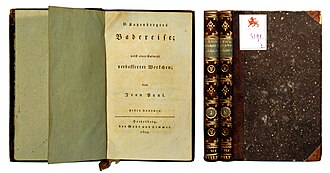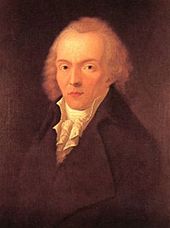Dr. Katzenberger's bathing trip
Dr. Katzenberger's Badereise is a satire by Jean Paul , which - written in 1807/1808 - was published by Mohr and Zimmer in Heidelberg at Easter 1809 . In 1822 the author experienced the new edition of the work.
content
The “wedded physician and anatomical professor Katzenberger from the University of Pira in the Principality of Zäckingen” is looking for company for the trip to Bad Maulbronn. Finally, Mr Theudobach von Nieß answers. Katzenberger is still traveling with his only daughter Theoda, but does not intend to use a spa treatment, but rather sets off on business. The Maulbronn fountain doctor Strykius has given Katzenberger's three main works poisonous reviews. The author wants to "beat the reviewer considerably" for this abuse of honor.
Nieß pretends to meet his friend, the great playwright Theudobach, in Maulbronn. But Nieß and Theudobach are one and the same person. Theoda, unsuspecting, longs for the rendezvous with the poet, the author of the well-known play "The Knight of a Better Age". On the way to Maulbronn, the young girl asks Nieß about Theudobach in the coach. Does the poet have a bride? Nieß has to say no, the blooming virgin wants to win, but does not have the courage. Then in Maulbronn, coincidence destroys his intention. Herr von Nieß invites the bathing company to a musical declamatory of the best Theudobach piece. The young Prussian military writer Hauptmann von Theudobach comes by in the concert hall and rightly claims the name for himself. It doesn't help that Nieß declares Theoda to be Theudobach von Nieß. The captain with the “blooming face and life” wins the race with Theoda, and the declamator Nieß tumbles down from his high car. The "eternal bond of life between two firm and pure hearts" is made.
The lovers only need the father's yes. The couple grabs Katzenberger with his "natural historical insatiability". The bride's father gives his “conditional yes”: If the captain really owns an estate there in Prussia with a “cave full of bear bones”, then the wedding should take place. Katzenberger, keen to travel, wants to personally convince himself of the manor and the bear cave. Everything will be fine. Jean Paul offers the reader a happy ending. How could it be any different! Katzenberger thinks that, despite all fatherly love, a girl cannot be passed on to a brave younger man in good time.
And Theoda, for her part, also loves the father - despite all his weaknesses, praises his fire for science, laments his lot of the learned, lonely giant. The weaknesses are not a few. The vengeance, i.e. the punishment of the cheeky reviewer, has already been mentioned. Further peculiarities had already come to light on the trip to Maulbronn. An innkeeper didn't want to know anything about Katzenberger because she remembered him as an exterminator. Kanker had put Katzenberger on the breadcrumbs, had eaten fat round spiders. The animals freshly hunted in the inn cellar tasted like hazelnuts. The omniscient narrator also reports: Katzenberger's penchant for anatomy goes so far that he will take any patient who will allow his or her future corpse opening into the cure for free. And the anatomy professor is particularly interested in studying any malformation. To this end, he would even enter the state of marriage with a female freak if she were not otherwise to be had more cheaply. So it is not surprising when on the trip Katzenberger steals a "well-stuffed, eight-legged double rabbit", such a grown-together rabbit-tête-à-tête, from a pharmacy and his counterpart Strykius "an old withered hand with six fingers" look away. The anatomist cheerfully collects bones from the church and wants to make a detour to the execution of a mail robber on the way. One could make galvanic experiments on the hanged man . Immediately after Theoda's best friend had a child, Katzenberger asked: “The boy is probably built very regularly?” And thus hides his scientific interest: the study of deformities. He calls the breastfeeding mammal. And anyway, all disadvantageous character traits are gathered in Katzenberger. With delight he stands on the street at night and watches the people through the cracks of their shutters. He also observes his daughter and her captain in this way. But the bride's father has to admit defeat against the “deep seriousness of love”.
Quote
"Theoda's heart trembled, but joyful, ... the world sounded back everywhere, and at last in the intoxication of the night it became as if she were standing with her lover again at the rock wall on which her life was decided. The villages, the cities, the tumult of the earth vanished, and only the stars and the mountains remained for love. The world seemed eternal to them, the stars only rose and none set. At last the star of love rose like a small, brightly flashing moon in the morning, the dawn glowed against them, and the sun drew into the glow of the roses. Behind them, over the mountains where they had found each other, a rainbow arched high into the sky. And so they arrived, one soul sunk into the other, pulling the night shimmer into the daylight, and their eyes were dreamy. O fate, why do you let so few of your people experience such a night, oh only an hour of it? They would never forget it, they would color the deserts of life with it as with the spring white and red - they would weep and languish, but not for the future, but for the past - and they would also say when they died : I was in Arcadia too! "
shape
The work consists of three ribbons. The Katzenberger , the actual story, is in 45 chapters (summula, Latin sum), which the reader finds in three sections in the middle of two prefaces and eleven little works.
- First ribbon
- Preface to the first and second volumes of the first edition
- Preface to the second edition
- First department
- Work
- Second ribbon
- Second division
- Work
- Third ribbon
- Third department
- Work
The "improved little works" that are announced in the title and - as is common with Jean Paul - stand incoherently next to the title story are:
- Homage sermon before and under the reign of the sun
- About lever's Alemannic poems
- Advice on original German baptismal names
- Dr. Fenk's funeral speech on the most blissful stomach
- About death after death; or the birthday
- The art of falling asleep
- The luck of being deaf in the left ear
- The destruction
- Wishes for Luther's monument from Musurus
- About Charlotte Corday
- Polymeter
reception
- In 1834, Laube commented on Jean Paul’s works, “The individual form is a continuous bulge, a long-sleeved style to the horror”. Laube excludes the “Katzenberger” from this blanket, devastating criticism. In 1889 Paul Nerrlich condemned - with Goethe as the absolute benchmark - the continuous " juvenility " in Jean Paul's works. Nerrlich also mentions the "Katzenberger" as a notable exception in his all-round blow.
- de Bruyn emphasizes a special feature of the work - its “compositionally closed fable”.
- Jean Paul parodies his "former emotional whimsy" in the Katzenberger . The happy ending is "a small break in style" ".
- Nieß is "the most ridiculous figure" in the bathing trip . Katzenberger, the well-read, sober natural scientist, defends himself "against the highs of exaggerated poetry".
- Katzenberger lacks any taste, and the feelings with Nieß and Theoda are wrong.
- Katzenberger in its rationality is the caricature of the natural scientist emerging in the 19th century.
- Schulz goes into Jean Paul's treatment of the disgusting as an amplifier of the ridiculous in connection with Lessing's art theory, but points out: Jean Paul wanted more; examined connections "between ugly and beautiful, bad and good, body and soul, devil and God, finitude and infinity".
- Jean Paul knew Bad Liebenstein and took it for Bad Maulbronn.
- While ETA Hoffmann approved the figure of the cynic Katzenberger, it was disapproved by Tieck , Platen and Jacob Grimm .
- In a nutshell, Zeller stated that this story was “poetry about poetry”.
filming
Gerd Winkler filmed Katzenberger in 1978 for ZDF. Actors: Hans Helmut Dickow , Horst Frank , Peter Lakenmacher , Jörg Pleva , Witta Pohl , Alwin Michael Rueffer and Jutta Speidel , film music: HE Erwin Walther .
literature
- source
- Norbert Miller (Ed.): Jean Paul: Dr. Katzenberger's bathing trip along with a selection of improved works. in: Jean Paul: Complete Works. Section I. Sixth Volume. Pp. 77-363. Scientific Book Society Darmstadt. License edition 2000 (© Carl Hanser Munich Vienna 1962 (4th, corr. Edition 1987), ISBN 978-3-446-10757-1 ). With notes in the appendix (pp. 1246–1268) and an afterword by Walter Höllerer (pp. 1329–1370)
- First edition
-
Jean Paul: D. Katzenberger's bathing trip; together with a selection of improved works . Mohr and Zimmer, Heidelberg 1809. 2 volumes
- First volume Mohr and Zimmer, Heidelberg 1809 ( digitized and full text in the German text archive )
- Second ribbon. Mohr and Zimmer, Heidelberg 1809. ( digitized and full text in the German text archive )
- expenditure
- Jean Paul: Dr. Katzenberger's bathing trip , (Vol. 1 and 2. Georg Reimer, Berlin 1828. (Jean Paul's complete works, Vol. 51 and 52 (of 65))). Half leather with gold embossing. Marble.
- Jean Paul: Dr. Katzenberger's bathing trip . With 10 colored pictures by Paul Scheurich . Hyperion Verlag Munich 1921. Cardboard tape with cover and spine vignette. A colored illustration as a frontispiece .
- Jean Paul: Dr. Katzenberger's bathing trip . Reclams Universal Library 18. 1986, ISBN 978-3-15-000018-2
- Jean Paul: Doctor Katzenberger's bathing trip . With an afterword and comments by Wolf Köbele, illustrations by Michael Blümel. Verlag Phosphoros 2001, ISBN 978-3-9806193-2-5
- Secondary literature
- Günter de Bruyn : The life of Jean Paul Friedrich Richter. A biography . Halle (Saale) 1975, ISBN 3-596-10973-6
- Peter Sprengel (ed.): Jean Paul in the judgment of his critics. Documents on the history of Jean Paul's impact in Germany . Beck. Munich 1980, ISBN 3-406-07297-6
- Gerhard Schulz : The German literature between the French Revolution and the restoration. Part 1. The Age of the French Revolution: 1789–1806. Munich 1983, ISBN 3-406-00727-9
- Hanns-Josef Ortheil : Jean Paul . Reinbek near Hamburg 1984, ISBN 3-499-50329-8
- Gerhard Schulz: The German literature between the French Revolution and the restoration. Part 2. The Age of the Napoleonic Wars and the Restoration: 1806–1830. Munich 1989, ISBN 3-406-09399-X
- Gert Ueding : Jean Paul . Munich 1993, ISBN 3-406-35055-0
- Christoph Zeller: Allegories of storytelling. Wilhelm Raabe's Jean-Paul reading. Metzler, Stuttgart 1999, ISBN 3-476-45218-2 .
Web links
- The text in Gutenberg's: Dr. Katzenberger's bathing trip
- The text at Zeno.org: Dr. Katzenberger's bathing trip along with a selection of improved works
annotation
- ↑ The main works: 1. Thesaurus Haematologiae (About the blood-making), 2. de monstris epistola (About the miscarriages), 3. fasciculus exercitationum in rabiem caninam anatomico-medico-curiosarum (About the fear of water).
Individual evidence
References to a citation are sometimes noted as (page, line from above).
- ↑ Source (1259.7) and also Robert Minder in: Sprengel, p. 292, 22. Zvo
- ↑ Source (84.2)
- ↑ Source (1246.29)
- ↑ Source (85.29)
- ↑ Ueding (313, 16)
- ↑ Source: 288.17
- ↑ Schulz anno 1983, pp. 153–155
- ^ Heinrich Laube in Sprengel, p. 138, 1. Zvo
- ^ Paul Nerrlich in Sprengel, p. 216, 15. Zvo
- ↑ de Bruyn (310.13)
- ↑ de Bruyn (311.7)
- ↑ de Bruyn (313.8)
- ↑ Ortheil (116: 12-35)
- ↑ Ueding (174.4-10)
- ↑ Ueding (174.25)
- ↑ Schulz in 1989 (357, 3rd Zvu to 358, 9th Zvo)
- ↑ Höllerer in the source (1359,30)
- ↑ Höllerer in the source (1359,32)
- ↑ Zeller, p. 271, 4th Zvu
- ↑ http://german.imdb.com/title/tt0077466/

